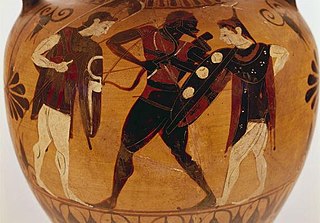
In Greek mythology, Styx is a river that forms the boundary between Earth (Gaia) and the Underworld. The rivers Acheron, Cocytus, Lethe, Phlegethon, and Styx all converge at the centre of the underworld on a great marsh, which sometimes is also called the Styx. According to Herodotus, the river Styx originates near Pheneus. Styx is also known as the goddess of the river, the source of its miraculous powers.

In Greek mythology, Oceanus was a Titan son of Uranus and Gaia, the husband of his sister the Titan Tethys, and the father of the river gods and the Oceanids, as well as being the great river which encircled the entire world.

The cubit is an ancient unit of length based on the distance from the elbow to the tip of the middle finger. It was primarily associated with the Sumerians, Egyptians, and Israelites. The term cubit is found in the Bible regarding Noah's Ark, Ark of the Covenant, Tabernacle, Solomon's Temple. The common cubit was divided into 6 palms × 4 fingers = 24 digits. Royal cubits added a palm for 7 palms × 4 fingers = 28 digits. These lengths typically ranged from 44.4 to 52.92 cm, with an ancient Roman cubit being as long as 120 cm.
Shaku or Japanese foot is a Japanese unit of length derived from the Chinese chi, originally based upon the distance measured by a human hand from the tip of the thumb to the tip of the forefinger. Traditionally, the length varied by location or use, but it is now standardized as 10/33 m, or approximately 30.3 centimeters (11.9 in).

Traditional Russian units of measurement were standardized and used in Imperial Russia and after the Russian Revolution, but it was abandoned after 21 July 1925, when the Soviet Union adopted the metric system, per the order of the Council of People's Commissars.

The digit or finger is an ancient and obsolete non-SI unit of measurement of length. It was originally based on the breadth of a human finger. It was a fundamental unit of length in the Ancient Egyptian, Mesopotamian, Hebrew, Ancient Greek and Roman systems of measurement.

The palm is an obsolete anthropic unit of length, originally based on the width of the human palm and then variously standardized. The same name is also used for a second, rather larger unit based on the length of the human hand.
Ancient Greek units of measurement varied according to location and epoch. Systems of ancient weights and measures evolved as needs changed; Solon and other lawgivers also reformed them en bloc. Some units of measurement were found to be convenient for trade within the Mediterranean region and these units became increasingly common to different city states. The calibration and use of measuring devices became more sophisticated. By about 500 BC, Athens had a central depository of official weights and measures, the Tholos, where merchants were required to test their measuring devices against official standards.

The earliest recorded systems of weights and measures originate in the 3rd or 4th millennium BC. Even the very earliest civilizations needed measurement for purposes of agriculture, construction and trade. Early standard units might only have applied to a single community or small region, with every area developing its own standards for lengths, areas, volumes and masses. Often such systems were closely tied to one field of use, so that volume measures used, for example, for dry grains were unrelated to those for liquids, with neither bearing any particular relationship to units of length used for measuring cloth or land. With development of manufacturing technologies, and the growing importance of trade between communities and ultimately across the Earth, standardized weights and measures became critical. Starting in the 18th century, modernized, simplified and uniform systems of weights and measures were developed, with the fundamental units defined by ever more precise methods in the science of metrology. The discovery and application of electricity was one factor motivating the development of standardized internationally applicable units.
A yojana is a measure of distance that was used in ancient India, Thailand and Myanmar. A yojana is about 12–15 km.

A cun, often glossed as the Chinese inch, is a traditional Chinese unit of length. Its traditional measure is the width of a person's thumb at the knuckle, whereas the width of the two forefingers denotes 1.5 cun and the width of four fingers side-by-side is 3 cuns. It continues to be used to chart acupuncture points on the human body, and, in various uses for traditional Chinese medicine.

In Greek mythology, Memnon was a king of Aethiopia and son of Tithonus and Eos. As a warrior he was considered to be almost Achilles' equal in skill. During the Trojan War, he brought an army to Troy's defense and killed Antilochus, Nestor's son, during a fierce battle. Nestor challenged Memnon to a fight, but Memnon refused, being there was little honor in killing the aged man. Nestor then pleaded with Achilles to avenge his son's death. Despite warnings that soon after Memnon fell so too would Achilles, the two men fought. Memnon drew blood from Achilles, but Achilles drove his spear through Memnon's chest, sending the Aethiopian army running. The death of Memnon echoes that of Hector, another defender of Troy whom Achilles also killed out of revenge for a fallen comrade, Patroclus.
There are a number of Spanish units of measurement of length or area that are virtually obsolete due to metrication. They include the vara, the cordel, the league and the labor. The units of area used to express the area of land are still encountered in some transactions in land today.

Snapping one's fingers is the act of creating a snapping or clicking sound with one's fingers. Primarily this is done by building tension between the thumb and another finger and then moving the other finger forcefully downward, so it hits the palm of the same hand at a high speed.
The stadion, also anglicized as stade, was an ancient Greek unit of length, consisting of 600 Ancient Greek feet (podes).
The kos, also spelled coss, koss, kosh, krosh, and krosha, is a unit of measurement which is derived from a Sanskrit term, क्रोश krośa, which means a 'call', as the unit was supposed to represent the distance at which another human could be heard. It is an ancient Indian subcontinental standard unit of distance, in use since at least 4 BCE. According to the Arthashastra, a krośa or kos is about 3,000 metres (9,800 ft).
Aṅgula is a measure of length. Twelve aṅgulas make a Vitasti or span, and twenty-four a Hasta or Cubit. 108 Angulam make a 'Dhanusha'. These measurements are claimed to have been used since the Harappan civilization and that these were also used for the construction of Taj Mahal.
In Greek mythology, the figure of Horkos personifies the curse that will be inflicted on any person who swears a false oath. He was the avenger of perjury and the punitive companion of the goddess Dike (Justice).
A number of units of measurement were used in Hungary to measure length, area, volume, and so on. The metric system was adopted in Hungary in 1874 and has been compulsory since 1876.









